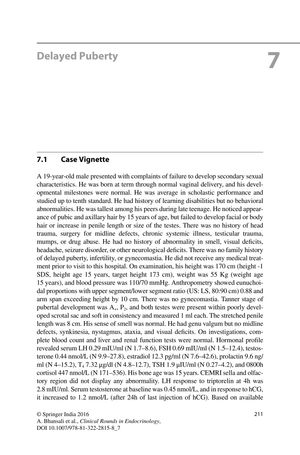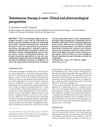Delayed Puberty: Diagnosis and Management of Congenital Idiopathic Hypogonadotropic Hypogonadism
January 2016
in “
Springer eBooks
”

TLDR A 19-year-old male with delayed puberty was successfully treated for a condition that prevents normal hormone production.
In 2016, a 19-year-old male with delayed puberty was diagnosed with congenital idiopathic hypogonadotropic hypogonadism (IHH) after presenting with eunuchoidal proportions, small testes, and low levels of luteinizing hormone (LH) and testosterone. He was treated with testosterone enanthate, with plans for gonadotropin therapy to induce spermatogenesis after virilization. The document also explores the role of leptin in puberty, the concept of "mini-puberty," and the prevalence and causes of delayed puberty, including CDGP and hypogonadism. It discusses diagnostic approaches, the importance of genetic testing, and the management of conditions like micropenis. The merits and demerits of using hCG and testosterone for pubertal induction in males with IHH are outlined, with combined gonadotropin therapy (hCG and FSH) recommended for initiating and maintaining spermatogenesis. Klinefelter's syndrome (KFS) is also discussed, emphasizing early diagnosis and management. Additionally, the document addresses gynecomastia, its causes, associated drugs, and treatment options, as well as testicular changes in delayed puberty and the evaluation of primary infertility in males.





